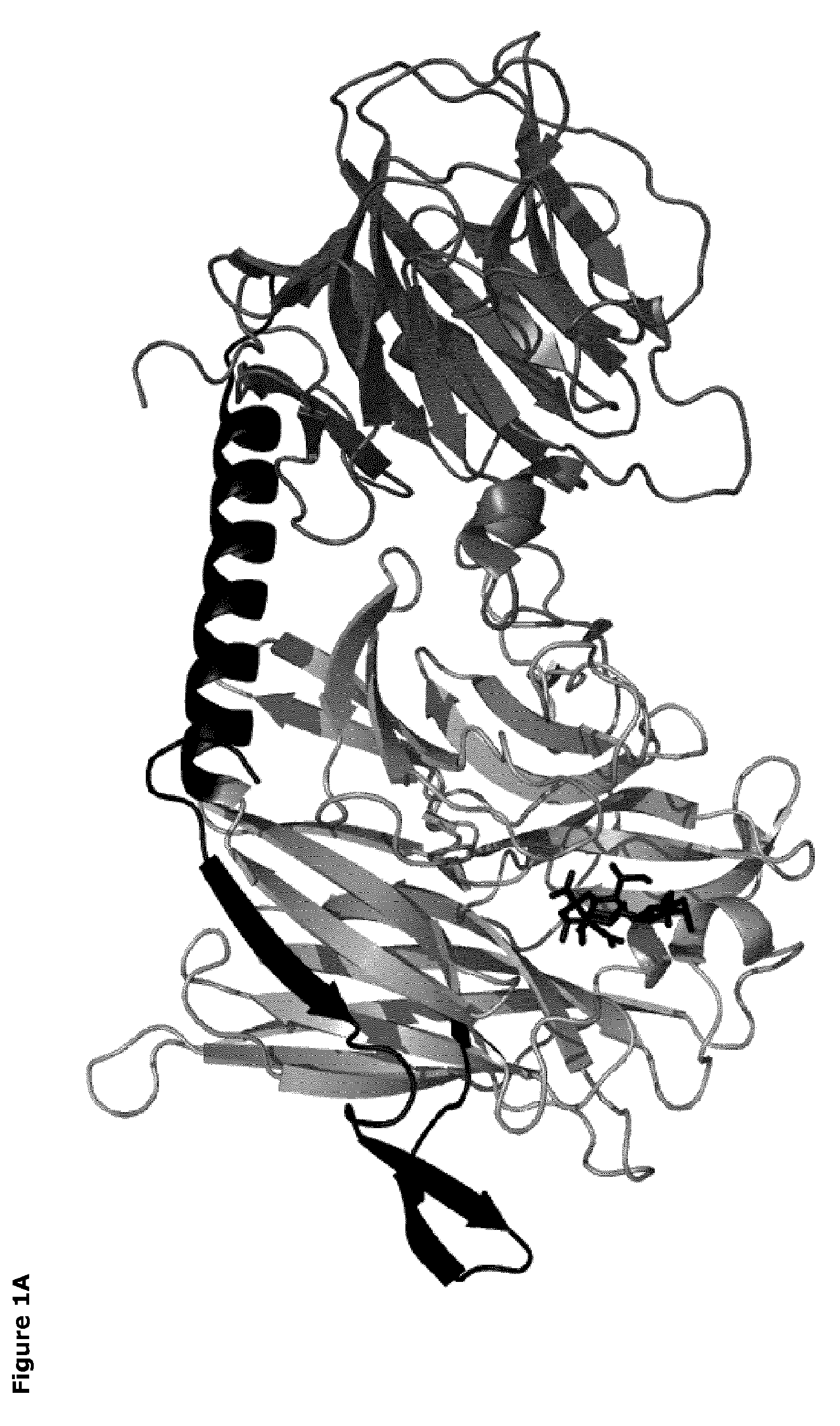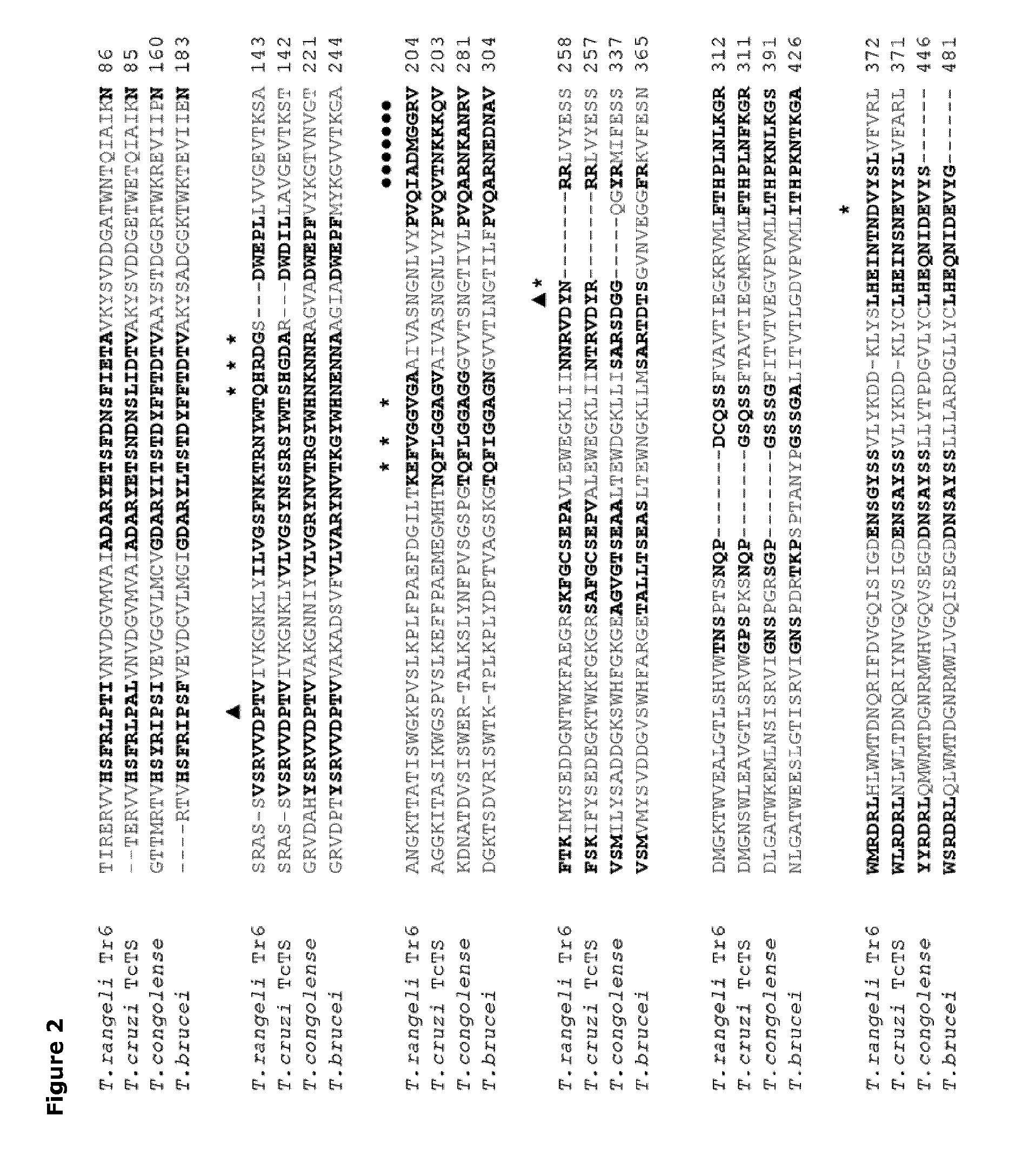A mutant sialidase having trans-sialidase activity for use in production of sialylated glycans
a technology of sialylated glycans and mutant sialidase, which is applied in the direction of biocide, sugar derivatives, enzymes, etc., can solve the problems of reducing the activity of sialylated glycans, reducing the activity of sialylated glycans, etc., to achieve the effect of reducing the activity of hydrolas
- Summary
- Abstract
- Description
- Claims
- Application Information
AI Technical Summary
Benefits of technology
Problems solved by technology
Method used
Image
Examples
example 1
Cloning and Expression of T. rangeli Sialidase Gene Mutants in Yeast
[0060]1.1 Construction of Vector Comprising Parent Sialidase Gene (pPICZα-Tr6)
[0061]A gene encoding a polypeptide comprising a T. rangeli sialidase (PDB 1WCS; SEQ ID NO. 1) with the following mutations, M96V, A98P, S120Y, G249Y, Q284P and I37L [12] was codon-optimized and synthesized by DNA 2.0 (Menlo Park, Calif., United States of America). The synthetic gene was inserted into PICZαC vector (Invitrogen) between the XbaI and XhoI restriction sites generating a gene (SEQ ID NO: 11) encoding a translational fusion comprising the mutant trans-sialidase (SEQ ID NO: 13) having a N-terminal α-factor signal sequence followed by Kex2 and Ste3 protease recognition sites (SEQ ID NO: 12), and a C-terminal c-myc and 6xHis tag (SEQ ID NO: 14). The encoded mature polypeptide has 662 amino acids, following removal of the signal peptide and protease recognitions sites, and a theoretical molecular mass of 73 kDa. The plasmid vector ...
example 2
Methods for Measuring the Trans-Sialidase and Sialidase Enzymatic Activity
2.1 Trans-Sialidase Activity Assay
[0065]Trans-sialidase activity was assayed as described previously [17] but with the following modifications. Reactions were performed in 50 mM phosphate-citrate (pH 6) at 30° C. using 2.9 μg / mL enzyme. The assay employed 1 mM cGMP-bound sialic acid as donor substrate and MU-Gal as the acceptor. MU-Gal at 0.5 mM was the highest final concentration to be tested due to its low solubility in aqueous solution. A solution of 87 mM MU-Gal in DMSO was diluted to 2 mM in 50 mM phosphate-citrate buffer (pH 6) immediately before preparing the reactions. When assaying crude enzyme preparations from P. pastoris, a background signal was observed, and attributed to cleavage of MU-Gal by endogenous β-galactosidase. This background signal could be removed by washing the column eight times with 440 μL of 5 mM HCl after sample application without desorption of the sialylated product and this wa...
example 3
A Positively-Charged Motif on the Border of the Binding Cleft of Sialidase Quenches its Hydrolytic Activity
3.1 Selection of Candidate Residues in Tr6 Sialidase for Mutation Screening
[0067]The catalytic domains of the sialidases were identified using NCBI Conserved Domain Search [10]. Pymol v1.3 (Schrödinger) was used to identify amino acids within 14 Å of the sialic acid binding site. The T. rangeli sialidase mutant Tr6 (see below) and trans-sialidases from T. cruzi (TcTS) (Uniprot ID Q26966), Trypanosoma congolense (Uniprot ID G0WJG3) and Trypanosoma brucei (Uniprot ID Q57XJ2) were aligned using ClustalW [11] (FIG. 2). Ranking of chemical difference between substituted amino acids in Tr6 vs. TcTS was done based on being first- or second sphere relative to the substrate and based on the polar / nonpolar and small / large distinction; such property-based selection turned out to correlate well with standard substitution matrices (BLOSUM62), i.e. the most unlikely substitutions were consid...
PUM
| Property | Measurement | Unit |
|---|---|---|
| Fraction | aaaaa | aaaaa |
| Nucleic acid sequence | aaaaa | aaaaa |
| Affinity | aaaaa | aaaaa |
Abstract
Description
Claims
Application Information
 Login to View More
Login to View More - R&D
- Intellectual Property
- Life Sciences
- Materials
- Tech Scout
- Unparalleled Data Quality
- Higher Quality Content
- 60% Fewer Hallucinations
Browse by: Latest US Patents, China's latest patents, Technical Efficacy Thesaurus, Application Domain, Technology Topic, Popular Technical Reports.
© 2025 PatSnap. All rights reserved.Legal|Privacy policy|Modern Slavery Act Transparency Statement|Sitemap|About US| Contact US: help@patsnap.com



